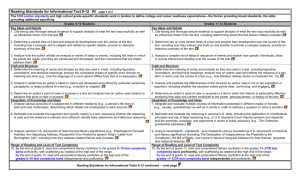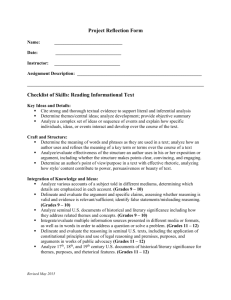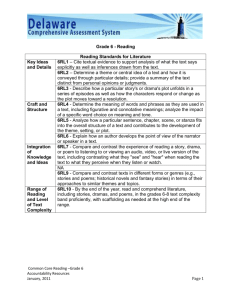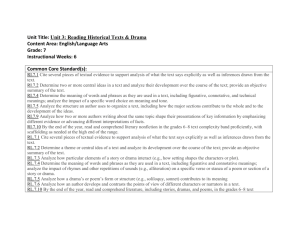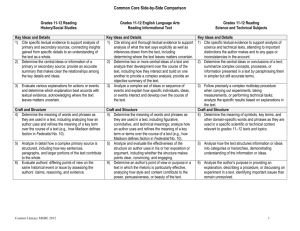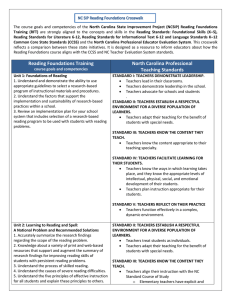Common Core Standards – Informational Text (6-12
advertisement
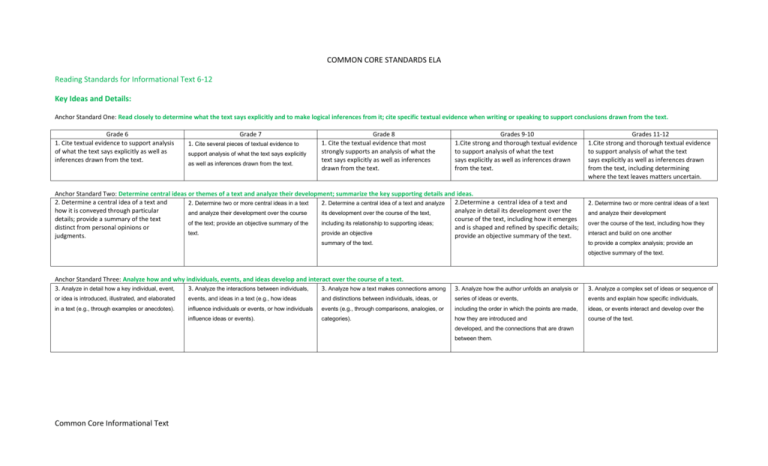
COMMON CORE STANDARDS ELA Reading Standards for Informational Text 6-12 Key Ideas and Details: Anchor Standard One: Read closely to determine what the text says explicitly and to make logical inferences from it; cite specific textual evidence when writing or speaking to support conclusions drawn from the text. Grade 6 1. Cite textual evidence to support analysis of what the text says explicitly as well as inferences drawn from the text. Grade 7 1. Cite several pieces of textual evidence to support analysis of what the text says explicitly as well as inferences drawn from the text. Grade 8 1. Cite the textual evidence that most strongly supports an analysis of what the text says explicitly as well as inferences drawn from the text. Grades 9-10 1.Cite strong and thorough textual evidence to support analysis of what the text says explicitly as well as inferences drawn from the text. Anchor Standard Two: Determine central ideas or themes of a text and analyze their development; summarize the key supporting details and ideas. 2. Determine a central idea of a text and 2. Determine two or more central ideas in a text 2. Determine a central idea of a text and analyze 2.Determine a central idea of a text and how it is conveyed through particular analyze in detail its development over the and analyze their development over the course its development over the course of the text, details; provide a summary of the text course of the text, including how it emerges of the text; provide an objective summary of the including its relationship to supporting ideas; distinct from personal opinions or and is shaped and refined by specific details; text. provide an objective judgments. provide an objective summary of the text. summary of the text. Grades 11-12 1.Cite strong and thorough textual evidence to support analysis of what the text says explicitly as well as inferences drawn from the text, including determining where the text leaves matters uncertain. 2. Determine two or more central ideas of a text and analyze their development over the course of the text, including how they interact and build on one another to provide a complex analysis; provide an objective summary of the text. Anchor Standard Three: Analyze how and why individuals, events, and ideas develop and interact over the course of a text. 3. Analyze in detail how a key individual, event, 3. Analyze the interactions between individuals, 3. Analyze how a text makes connections among 3. Analyze how the author unfolds an analysis or 3. Analyze a complex set of ideas or sequence of or idea is introduced, illustrated, and elaborated events, and ideas in a text (e.g., how ideas and distinctions between individuals, ideas, or series of ideas or events, events and explain how specific individuals, in a text (e.g., through examples or anecdotes). influence individuals or events, or how individuals events (e.g., through comparisons, analogies, or including the order in which the points are made, ideas, or events interact and develop over the influence ideas or events). categories). how they are introduced and course of the text. developed, and the connections that are drawn between them. Common Core Informational Text Craft and Structure: Anchor Standard Four: Interpret words and phrases as they are used in a text, including determining technical, connotative, and figurative meanings, and analyze how specific word choices shape meaning or tone. Grade 6 4. Determine the meaning of words and phrases Grade 7 Grade 8 Grades 9-10 Grades 11-12 4. Determine the meaning of words and phrases 4. Determine the meaning of words and phrases 4. Determine the meaning of words and phrases 4. Determine the meaning of words and phrases as they are used in a text, including figurative, as they are used in a text, including figurative, as they are used in a text, including figurative, as they are used in a text, as they are used in a text, connotative, and technical meanings. connotative, and technical meanings; analyze the connotative, and technical meanings; analyze the including figurative, connotative, and technical including figurative, connotative, and technical impact of a specific word choice on meaning and impact of specific word choices on meaning and meanings; analyze the meanings; analyze how an author tone. tone, including analogies or allusions to other cumulative impact of specific word choices on uses and refines the meaning of a key term or texts. meaning and tone (e.g., how the terms over the course of a text language of a court opinion differs from that of a (e.g., how Madison defines faction in Federalist newspaper). No. 10). Anchor Standard Five: Analyze the structure of texts, including how specific sentences, paragraphs, and larger portions of text (e.g., a section, chapter, scene, or stanza) relate to each other and the whole. 5. Analyze how a particular sentence, paragraph, 5. Analyze the structure an author uses to 5. Analyze in detail the structure of a specific 5. Analyze in detail how an author’s ideas or 5. Analyze and evaluate the effectiveness of the chapter, or section fits into the overall structure of organize a text, including how the major sections paragraph in a text, including the role of claims are developed and refined by structure an author uses in his or a text and contributes to the development of the contribute to the whole and to the development particular sentences in developing and refining a particular sentences, paragraphs, or larger her exposition or argument, including whether ideas. of the ideas. key concept. portions of a text (e.g., a section or the structure makes points clear, chapter). convincing, and engaging. Anchor Standard Six: Assess how point of view or purpose shapes the content and style of text. 6. Determine an author’s point of view or purpose 6. Determine an author’s point of view or 6. Determine an author’s point of view or purpose 6. Determine an author’s point of view or purpose 6. Determine an author’s point of view or purpose in a text and explain how it is conveyed in the purpose in a text and analyze how the author in a text and analyze how the author in a text and analyze how an in a text in which the rhetoric is text. distinguishes his or her position from that of acknowledges and responds to conflicting author uses rhetoric to advance that point of view particularly effective, analyzing how style and others. evidence or viewpoints. or purpose. content contribute to the power, persuasiveness, or beauty of the text. Common Core Informational Text Integration of Knowledge and Ideas Anchor Standard Seven: Integrate and evaluate content presented in diverse media and formats, including visually and quantitatively, as well as in words. Grade 6 7. Integrate information presented in different 7. Compare and contrast a text to an audio, Grade 7 7. Evaluate the advantages and disadvantages Grade 8 7. Analyze various accounts of a subject told in Grades 9-10 7. Integrate and evaluate multiple sources of media or formats (e.g., visually, quantitatively) as video, or multimedia version of the text, of using different mediums (e.g., print or digital different mediums (e.g., a person’s life story in information presented in different media or well as in words to develop a coherent analyzing each medium’s portrayal of the subject text, video, multimedia) to present a particular both print and multimedia), determining which formats (e.g., visually, quantitatively) as well as understanding of a topic or issue. (e.g., how the delivery of a speech affects the topic or idea. details are emphasized in each account. in words in order to address a question or solve a impact of the words). Grades 11-12 problem. Anchor Standard Eight: Delineate and evaluate the argument and specific claims in a text, including the validity of the reasoning as well as the relevance and sufficiency of the evidence. 8. Trace and evaluate the argument and specific 8. Trace and evaluate the argument and specific 8. Delineate and evaluate the argument and 8. Delineate and evaluate the argument and 8. Delineate and evaluate the reasoning in claims in a text, distinguishing claims that are claims in a text, assessing whether the reasoning specific claims in a text, assessing whether the specific claims in a text, assessing seminal U.S. texts, including the supported by reasons and evidence from claims is sound and the evidence is relevant and reasoning is sound and the evidence is relevant whether the reasoning is valid and the evidence application of constitutional principles and use of that are not. sufficient to support the claims. and sufficient; recognize when irrelevant is relevant and sufficient; identify false legal reasoning (e.g., in U.S. evidence is introduced. statements and fallacious reasoning. Supreme Court majority opinions and dissents) and the premises, purposes, and arguments in works of public advocacy (e.g., The Federalist, presidential addresses). Anchor Standard Nine: Analyze how two or more texts address similar themes or topics in order to build knowledge or to compare the approaches the authors take. Common Core Informational Text 9. Compare and contrast one author’s 9. Analyze how two or more authors writing 9. Analyze a case in which two or more texts 9. Analyze seminal U.S. documents of historical 9. Analyze seventeenth-, eighteenth-, and presentation of events with that of another (e.g., about the same topic shape their presentations provide conflicting information on the same topic and literary significance (e.g., nineteenth-century foundational U.S. a memoir written by and a biography on the of key information by emphasizing different and identify where the texts disagree on matters Washington’s Farewell Address, the Gettysburg documents of historical and literary significance same person). evidence or advancing different interpretations of of fact or interpretation. Address, Roosevelt’s Four (including The Declaration of Freedoms speech, King’s “Letter from Independence, the Preamble to the Constitution, Birmingham Jail”), including how they the Bill of Rights, and Lincoln’s address related themes and concepts. Second Inaugural Address) for their themes, facts. purposes, and rhetorical features . Range of Reading and Level of Text Complexity Anchor Standard Ten: Read and comprehend complex literary and informational texts independently and proficiently. 10. By the end of the year, read and comprehend 10. By the end of the year, read and comprehend 10. By the end of the year, read and comprehend 10. By the end of grade 9, read and comprehend 10. By the end of grade 11, read and comprehend literary nonfiction in the grades 6–8 text literary nonfiction in the grades 6–8 text literary nonfiction at the high end of the grades literary nonfiction in the grades literary nonfiction in the grades complexity band proficiently, with scaffolding as complexity band proficiently, with scaffolding as 6–8 text complexity band independently and 9–10 text complexity band proficiently, with 11–CCR text complexity band proficiently, with proficiently. scaffolding as needed at the high end of the range. scaffolding as needed at the high end of the range. By the end of grade 10, read and comprehend By the end of grade 12, read and comprehend literary nonfiction at the high literary nonfiction at the high end of the grades 11– end of the grades 9–10 text complexity band CCR text complexity band independently and independently and proficiently. proficiently needed at the high end of the range. Common Core Informational Text needed at the high end of the range.
